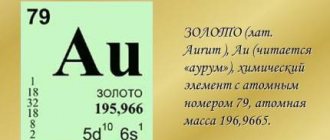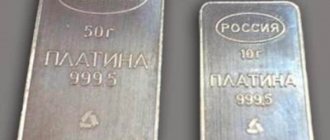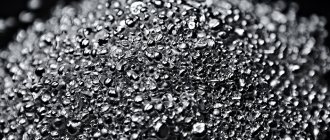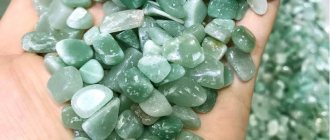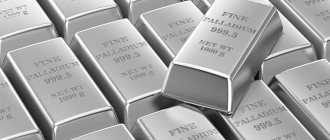In the Middle Ages, Europeans called Rus' Ruthenia. For them, these lands were the territory of “rebellious tribes”, “savages and pagans”, incomprehensible and unpredictable peoples.
Our current hero is named after Ruthenia very “on point”. Metal is still largely mysterious, unexplained and sometimes explosive - like Russia itself. So K. Klaus, who gave the name to the platinoid, hit the bull's eye.
Ruthenium is a very hard and refractory, but very brittle platinum group metal.
How metal was discovered
Ruthenium came into the sphere of interest of scientists in the mid-19th century, when platinum fever began in the Urals.
However, the story turned out to be complicated:
- In 1827, a German chemist and professor at the University of Dorpat, Gottfried Ozanne, completed a series of works on “unpacking” Ural ore. The presence of three metals unknown to science was discovered, which he named polyne, poluran, and ruthenium.
- The achievement did not resonate with colleagues: most considered it a mistake. And the resulting substance is poorly purified platinum iridium.
- Thirteen years later, Karl Klaus, an ethnic German who was born in Russia and became a professor at Kazan University, undertook to repeat Ozanne’s experiments. He was assisted by the Polish scientist Andrzej Sniadecki.
- Four years later (1844) they introduced about 6 grams of ruthenium. Thus, a new element was discovered and Ozanne’s results were confirmed.
- Scientists examined the physical and chemical properties, established the atomic mass, and the amount of ruthenium - 1.1%.
The metal is named after the country where it was first discovered. This is what the discoverer Gottfried Ozanne suggested. Russia took its place in the periodic table.
Ruthenia is a Latinized version of the toponym Russia. This is how the state was called Europe until the 15th century.
According to another version, the same Snyadetsky was the first to study this chemical element back in 1809. He named the new element vestia, after the asteroid Vesta, discovered two years earlier.
The Soviet scientist S.M. Starostin devoted his entire life to the study of metal.
Karl Karlovich Klaus, “father” of ruthenium
In the history of the study of platinum group metals, several scientists stand out. Among them is K. Klaus - chemist, pharmacist, philosopher.
Karl Klaus, Russian chemist, pharmacist and botanist, founder of the chemistry of platinum and its satellites in Russia, teacher of A.M. Butlerov, corresponding member of the St. Petersburg (1861) and Berlin (1863) Academy of Sciences.
When he was just a baby, he was left an orphan. He lived in poverty, didn’t even finish high school, but was distinguished by his curiosity and studied on his own. Therefore, he managed to pass the exam to become a pharmacist. He moved to Kazan and became the manager of a pharmacy. At the age of 32, being married and having three children, he decided to continue his studies.
Talented people have a wide range of interests. Klaus took up botany and studied the plants of the Volga steppes. And when I was studying (I had to feed my family), I worked as a laboratory assistant.
He graduated from the University of Dorpat, defended his dissertation, and again left for Kazan. Here he headed a chemical laboratory at Kazan University - and became interested in chemistry.
The card suits a good player. In 1840, platinum ore was sent to the university, and research began.
After four years of work, a new platinum metal was discovered - a metal called ruthenium. The reward for the discovery was not small. The scientist received the Demidov Prize (5,000 rubles), an impressive amount for those times.
Klaus wrote about his discovery:
“I worked on this item for more than a whole year, but finally discovered an easy and sure way to obtain it in a pure state. This new metal, which I named ruthenium in honor of our Fatherland.”
Physico-chemical characteristics
Ruthenium is endowed with characteristics characteristic of other platinoids: increased hardness (6.5 Mohs), resistance to chemical substances, including aggressive ones.
| Properties of the atom | |
| Name, symbol, number | Ruthenium (Ru), 44 |
| Atomic mass (molar mass) | 101.07(2) a. e.m. (g/mol) |
| Electronic configuration | [Kr] 4d7 5s1 |
| Atomic radius | 134 pm |
| Chemical properties | |
| Covalent radius | 125 pm |
| Ion radius | (+4e) 67 pm |
| Electronegativity | 2.2 (Pauling scale) |
| Electrode potential | 0 |
| Oxidation states | +3, +4, +6, +8, 0 |
| Ionization energy (first electron) | 710.3 (7.36) kJ/mol (eV) |
| Thermodynamic properties of a simple substance | |
| Density (at normal conditions) | 12.41 g/cm³ |
| Melting temperature | 2334 °C (2607 K, 4233 °F) |
| Boiling temperature | 4077 °C (4350 K, 7371 °F) |
| Ud. heat of fusion | (25.5) kJ/mol |
| Molar heat capacity | 24.0 J/(K mol) |
| Molar volume | 8.3 cm³/mol |
| Crystal lattice of a simple substance | |
| Lattice structure | hexagonal |
| Lattice parameters | a=2.706 c=4.282 Å |
| c/a ratio | 1,582 |
| Debye temperature | 600 K |
| Other characteristics | |
| Thermal conductivity | (300 K) 117.0 W/(m K) |
| CAS number | 7440-18-8 |
There are distinctive features:
- Effective hydrogen sorbent: a ruthenium cube with an edge of 1 cm is capable of absorbing 1500 cm3 of hydrogen. This is almost twice as much as palladium (940 cm3), recognized as the standard for this characteristic.
- The properties of tetravalent ruthenium oxide are interesting. Externally, these are yellow needles with a golden tint. Even at room temperature (25°C) they melt to liquid, emitting the smell of ozone. Without this component, it is impossible to separate ruthenium from other metals and achieve maximum purification.
The metal is fragile and easily abraded to powder.
Production prospects
Despite the fact that the world's reserves of ruthenium are small and amount to 5,000 tons, the metal is considered a waste. This mineral is not mined in its pure form, but is isolated during platinum production. Expensive metal is mainly purchased by industrialists; it is valuable now and will continue to be valuable. Today, there are known cases of using ruthenium for the synthesis of diamonds.
Already today this noble metal is trying to compete with platinum, iridium and rhodium. Scientists believe that in the future much can be expected from the use of ruthenium coating, which increases the resistance of the product to corrosion, mechanical and chemical damage. This unique property of the metal, such as the ability to absorb and transmit hydrogen, can later be used to produce pure hydrogen.
Metal in nature
In terms of prevalence, ruthenium is perhaps the rarest of the noble metals: its share in the earth’s crust is 1x2-6%. Meteorites contain 200 times more substance.
The total mass of explored reserves of ruthenium is estimated at 5 thousand tons.
The mineral is found using the following markers:
- Bedrock deposits or placers of platinum-bearing rocks.
- Deposits of copper-nickel ores.
- Deposits of laurite and ruthenarsenide.
Laurite and ruthenarsenide are ruthenium's own minerals. The first is dark, dense, rich in ruthenium. Both are extremely rare.
Mysterious and rich
The name and history of the discovery of ruthenium are inextricably linked with Russia. At the very beginning of the 19th century, the world community was excited and concerned by the news that the richest deposits of platinum had been discovered in the Russian Empire. There were rumors that in the Urals the extraction of this precious metal could be carried out with an ordinary shovel. The fact of the discovery of rich deposits was soon confirmed by the fact that the Minister of Finance of Russia E.F. Kankrin sent the highest decree to the St. Petersburg Mint on the minting of coins from platinum. In subsequent years, about one and a half million coins (3.6 and 12 rubles) were put into circulation, the production of which required 20 tons of precious metal.
Where is it mined?
Ruthenium is mined in the same place as platinum or platinoids:
- SOUTH AFRICA;
- Zimbabwe;
- Russia;
- China;
- USA.
The main supplier of raw materials is the Republic of South Africa.
The annual global ruthenium production rate is 17-21 tons.
Receiving technologies
- Ruthenium is extracted from platinum or nickel-copper ore. Moreover, they do this when the raw materials are “purified” of other valuable elements. That is, the main source of the metal is the waste remaining as a result of the purification of platinum or metals of its group. The full cycle (including ore enrichment and thermochemical treatment) takes one and a half months.
- The second source is the contents of spent fuel rods, nuclear waste. The materials are uranium, thorium, and plutonium. A ton of radioactive decay product contains up to 250 grams of ruthenium.
- The third is a technetium isotope irradiated by a neutron flux.
Who is guilty?
More recently, scientists in Western Europe seriously worried the public with a message that the content of the radioactive isotope of ruthenium Ru106 was growing over the continent. Experts completely exclude its self-education in the atmosphere. As well as an emergency release from a nuclear power plant, since then cesium and iodine radionuclides would necessarily be present in the air, which is not confirmed by experimental data. The impact of this isotope on the human body, like any radioactive element, leads to irradiation of tissues and organs and the development of cancer. Possible sources of pollution, according to Western media, are located in Russia, Ukraine or Kazakhstan.
In response, a representative of the Rosatom Communications Department stated that all enterprises of the state corporation were and are working as usual. The International Atomic Energy Agency (IAEA), in its conclusion, based on its own monitoring data, called all accusations against the Russian Federation groundless.
Where is it used?
Noble metal is in demand as a self-sufficient element and component of alloys.
Industry
The main consumer of metal.
The following industries take it:
- Electronics production.
- Electrochemistry.
- Chemical production.
These areas use 90% of raw materials.
Chemists value the metal for its inertness and catalyst properties:
- It is endowed with the unique property of selectivity in reactions. For this it is in demand in the synthesis of organic and inorganic substances.
- When paired with it, the catalytic activity of platinum increases.
- Ruthenium compounds are used as superoxidants, pigments in glass and enamels.
Advanced industries cannot do without ruthenium as an alloy element:
- They are used to make components and contacts of high-precision devices for the needs of radio, electrical, aerospace technology, and the defense complex. For this, 1.1-4.9% ruthenium in the alloy is sufficient.
- 0.1% ruthenium added to titanium multiplies the anti-corrosion properties of the latter.
- Ruthenium-platinum symbiosis is a material for the manufacture of fuel systems and water purification systems on spacecraft.
- Refractory metal is added to alloys in the manufacture of instruments that measure ultra-high temperatures.
Pure ruthenium is used to coat particularly important parts to make them more mechanically and chemically stable.
Jewelry
In jewelry, the use of metal is twofold: as a reinforcing component of the alloy and as a durable coating .
Products made from alloys with ruthenium alloy are reliable and durable, which is important for jewelry that experiences increased loads (rings, rings, bracelets).
Ruthenium coating creates a film on the surface of the product in a range of shades from graphite to black.
Together with rhodium they create elite black gold.
Industrial production
The element ruthenium is considered a noble element, and the main source of the metal is waste rocks from platinum production. The undisputed leader in the production of ruthenium (as well as platinum) is the Republic of South Africa. The development and production of this metal is also carried out by Russia, Canada and Zimbabwe. By the way, the latter country ranks second in the world in terms of explored reserves of platinum group metals.
The amount of ruthenium supplied to the market ranges from 17 to 20 tons per year. The production cycle of the element lasts about 6 weeks and is a continuous chain of thermochemical reactions following one another.
A technology has been developed for producing ruthenium by neutron irradiation of radioactive technetium isotopes. But it should be noted that the isolation of a pure and stable metal, due to its chemical properties, unpredictability and insufficient knowledge, remains still a pipe dream.
What is interesting for scientists
Ruthenium has cast a spell on many generations of scientists. It turned out that some of its characteristics almost copy the platinoids rhodium and osmium, others - iron.
But almost two hundred years after the discovery of the element, questions remain:
- The main obstacle is created by valence. Ruthenium has eight types. This is not the worst thing. During experiments, valence spontaneously and unexpectedly changes.
- Non-standard catalytic capabilities. It is difficult to vouch for the outcome of the process: the metal itself “decides” which element to help accelerate and which not.
Therefore, it has not yet been possible to obtain stable pure metal.
These circumstances only provoke scientists, especially young people. They intend to tame the wayward metal. Particularly attractive areas are the complete and economically optimal extraction of the element from minerals, sludge, and nuclear waste.
Biological effects
Like platinum, nanodoses of ruthenium are present in the tissues of biological organisms (in humans, these are muscles).
The metal and its compounds are biologically active. This property is used by dermatologists, oncologists, and phthisiatricians.
Of particular note is the inorganic dye known as “ruthenium red.” It contrasts tissue and other biological substances examined under a microscope.
However, there are compounds that are dangerous to humans:
- Dioxide Very poisonous, causes vomiting and suffocation. Provokes allergies, ulcers on the mucous membranes.
- Quadrivalent oxide . Exposure to organics (for example, alcohol) or heating above 100°C is enough to cause an explosion.
This should be taken into account if there are fans of home chemical experiments in the family. Such substances are stored in special containers.
Biological significance
Ruthenium has the ability to accumulate in living tissue cells, mainly muscle cells (the only one of the platinum group metals). May provoke the development of allergic reactions and have a negative effect on the mucous membrane of the eyes and upper respiratory tract.
In medicine, the noble metal is used as a means to recognize affected tissues. Medicines based on it are used to treat tuberculosis and various infections that affect human skin. For this reason, the use of ruthenium’s ability to form strong nitroso complexes in the fight against diseases associated with excessive concentrations of nitrates in the human body (hypertension, arthritis, septic shock and epilepsy) looks very promising.
Interesting Facts
There are many interesting facts associated with silver-colored metal.
- Ruthenium is the only metal that has been isolated in Russia by extraction from mineral raw materials.
- Until now, no one has been able to extract 100% stable ruthenium, since the element is characterized by high chemical activity.
- Ruthenium is a very refractory metal; in this characteristic it is second only to rhenium, osmium, molybdenum, iridium, tungsten, tantalum, and niobium.
- The uniqueness of ruthenium lies in its multivalency; it can appear in 9 different valences.
- This noble metal cannot be dissolved in acid and aqua regia.
- This element is considered the only one that has the ability to bind airborne nitrogen into a chemical compound. Some types of bacteria have this ability.
- One substance found in nature that contains ruthenium is laurite.
- Relatively large amounts of ruthenium are found in Russia, Canada and the USA.
- Ruthenium is a rare high-valent metal with unique properties. Its higher oxide is considered a rather toxic substance.
As a strong oxidizing agent, ruthenium can cause combustion of flammable substances.
Sources
- https://himya.ru/rutenij.html
- https://jgems.ru/metally/rutenij
- https://vplate.ru/metally-i-splavy/o-rutenii/
- https://chem.ru/rutenij.html
- https://your-online.ru/electronic-formulas/Ru
- https://k-tree.ru/tools/chemistry/periodic.php?element=Ru
- https://FB.ru/article/356482/ruteniy—himicheskiy-element-opisanie-istoriya-i-sostav
- https://TheMineral.ru/metally/rutenij
- https://himsnab-spb.ru/article/ps/ru/
